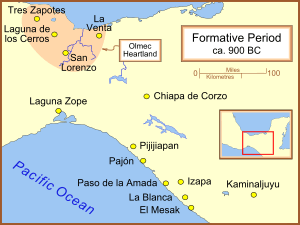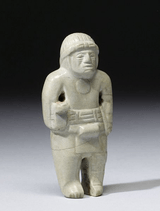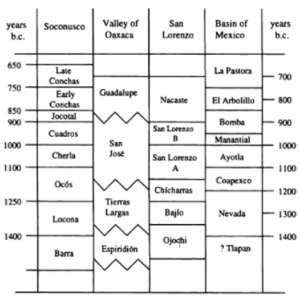Paso de la Amada facts for kids
Paso de la Amada is an ancient place in Chiapas, a state in Mexico. It's located near the Gulf of Tehuantepec, in a region called Soconusco. This area was once home to the Mokaya people. They lived here a very long time ago, from about 1800 BCE to 1000 BCE. The site covered a large area, about 50 hectares.
Paso de la Amada is famous for having the oldest ballcourt ever found in Mesoamerica. It also shows how early societies started to become more organized. This includes having different social groups and leaders. Some experts believe it shows early connections with the Olmec people.
Contents
Finding and Digging Up the Site
A person named Jorge Fausto Ceja Tenorio first found this ancient site in 1974. He later started digging there to learn more. Other researchers, like John E. Clark and Michael Blake, also studied the mounds at Paso de la Amada. They wanted to understand how society was structured in those early times.
Another nearby site called San Carlos helped explain many things found at Paso de la Amada. People think these two places had a close connection.
The Oldest Ballcourt
In 1995, archaeologists made an exciting discovery: they found the remains of a ballcourt. This court is very old, dating back to about 1400 BCE. It is about 80 meters (262 feet) long and 8 meters (26.2 feet) wide. The court was built between two long, low mounds.
What's interesting is that this ballcourt was not in a public meeting place. Instead, it was found near the homes of important people. This suggests that the ballgame might have been played mostly by the leaders or special members of society.
Mound 6: A Look at Early Leaders
Mound 6 is the biggest structure at Paso de la Amada. It gives us clues about how social structures changed over time. Researchers found six different layers of buildings on this mound.
- First Building: The first building, called Structure 6, was built directly on the ground. It was likely a common area or a meeting place for everyone, perhaps like a "men's house."
- More Complex: Structure 5 was built next. It was a bit more complex, with more posts inside and more space for sitting.
- Rising Up: Then came Structure 4. This building was placed on a small platform, making it higher than other buildings. It had many posts, fireplaces, and clay floors.
- Getting Smaller: As time went on, Structure 3 was built even higher, but the actual building became smaller.
- Community Effort: The last main building, Structure 2, was a huge project. It would have taken many people a long time to build. Experts guess it took about 20 people around 25 days to complete.
Why Mound 6 Is Important
Mound 6 helps us understand how early farming villages grew into more complex societies. At first, buildings were open and used by many people. But over time, the buildings on Mound 6 became smaller. This means fewer people could gather inside.
Also, the platform under the buildings grew larger. Building such a big platform needed many people working together. If a large group built something for a smaller group, it suggests there were leaders. These leaders must have told people what to do.
Mound 6 is important because it's hard to find out about the political leaders of these very old societies. This mound shows that people worked together on big projects. It also suggests that power became more focused on a smaller group of people over time. The mound might have been built to show off the power of these leaders.
Olmec Connections
Some archaeologists believe that traders from the Olmec civilization visited the Paso de la Amada area around 1150 BCE or even earlier. These visits might have influenced the social structure of the region. It's thought that the Olmec influence led to another site, Cantón Corralito, becoming a more important center than Paso de la Amada.
See also
In Spanish: Paso de la Amada para niños





